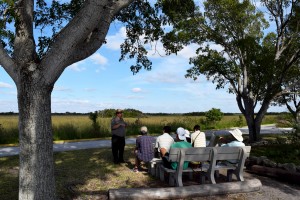
A threat to the keeper of the Everglades
SHARK VALLEY, Fla. — It’s a warm afternoon at Shark Valley, one of the visitor centers of the Everglades National Park.
While guests sit on the wood benches under the mahogany trees across from the visitor center, Park Ranger Chris Littlejohn puts on his campaign hat and heads outside, ready to give the Shark Byte talk of the day.
Littlejohn, as part of a series of ranger-led talks about South Florida’s Everglades, will talk about a specie that is on its way to dethrone the alligator as the “keeper of the Everglades,” the Burmese python.
 |
Park Ranger Chris Littlejohn talks to Shark Valley visitors about pythons, as part of the Shark Byte talks (Photos by Yael Herman). |
“They used to be the biggest, baddest dude on the block,” said Littlejohn of the alligators. “Now with the pythons, we’ll see how that goes.”
Responsible for eating 90 percent of the mammals in the Everglades, the pythons have no known predator in the 1.5 million acre park. They’re an invasive species, they’re destroying the balance of the park’s ecosystem, and experts think eradication will be impossible.
“They’re probably here to stay,” said Don DeAngelis, a biology professor at the University of Miami.
In terms of how many pythons there are, estimates are as low as 10,000 and as high as 150,000. And reproduction is fast; female pythons can store semen for two to three years and lay as many as 100 eggs. “We just have no clue how many there are,” said Littlejohn, who has worked at the Everglades since July.
On top of the immeasurable amount, they’re hard to catch. Pythons are excellent at camouflage; visitors could be walking the trails while a python hides just feet away, and they won’t see it.
In December 2010, the Florida Fish and Wildlife Commission announced the 2013 Python Challenge. Up for grabs were $1,500 for the team who caught the most pythons, and $1,000 for the team who caught the longest one. A total of 1,600 permits were issued and, over the course of one month, only 68 pythons were caught.
| Click on the video at the left to view an audio slideshow about pythons in Everglades National Park prepared by writer Yael Herman. |
“Hunting is not working, and it this point it’s gone too late,” said Larry Brand, a professor in the Department of Marine Biology and Ecology at the University of Miami.
In addition, Littlejohn said, the park service doesn’t have enough staff, or money, to patrol the park at night and the pythons are night hunters.
“Twenty years ago, there were deer here,” said Tom Southern, a naturalist who attended the talk. “I never see deer anymore or rabbits.”
Wading birds, who were safe from the alligators, are also threatened, as small pythons can climb up the trees, said DeAngelis.
“It’s a real possibility, as they start moving north, they could have huge impacts on wading bird colonies,” he said.
As for how a snake native to Southeast Asia ended up in South Florida, Littlejohn believes it was a “combination of irresponsible pet owners and accidental releases.”
Between 1990 and 2006, about 112,000 pythons were imported through Miami. Pet owners could get them for $20, but didn’t realize that in six months, their 20-inch snakes would be between five and six feet long. The more they fed them, the more they grew and it became impossible for many to keep them as pets.
“People decided they would put their snakes in a container in the trunk and release them driving along Tamiami Trail,” said Littlejohn, as he unfolded the skin of a 15-foot python caught by rangers two years ago. “Some people did go to Royal Palm and ask rangers to release them, but the rangers would flip out and say no, so they did it anyway.”
 |
Park Ranger Chris Littlejohn unfolds the skin of a recently caught python with the help of visitor Tom Southern at the Everglades National Park. |
Another factor might be Hurricane Andrew. Experts believe that when it wiped out everything in 1992, snakes that were in captivity at zoos and at other places for research were released into the wild.
So far, no solution has been found.
“I don’t even know if were sustaining the problem right now,” said Littlejohn, visibly worried.
All possible solutions also come with a myriad of problems. Rat poison can affect other animals in the area. Researchers are also working on a biological disease that can be injected to some of the pythons, hoping that as they mate, the disease spreads and slowly kills them off. But this could also kill the alligators that eat the pythons. Traps with pheromones to lure male pythons are the most recent attempt, and it has yet to be determined whether it worked.
“It’s going to have to be some biological control most likely, but they’re struggling to find it,” said Brand.
As of now, pythons are contained in South Florida, with no sightings reported in other areas. But Littlejohn warns, it’s not just an Everglades problem. “It just takes one snake to go north and start reproducing.”
In what seems like a game of assumptions and estimates, we better pray that the problem be contained soon, and that it doesn’t spread to other areas of the country.
If You Go
- Shark Byte talks at Shark Valley schedules vary by season. Topics vary by day. Call ahead to verify, 305-221-8776.
- Shark Valley Visitor Center, 36000 SW 8th St., Miami, Fla. 33194
If You See a Python
- Call the Florida Invasive Species Partnership at 1-888-Ive-Got1 (483-4681), or report online at IveGot1.org
- There’s also an app for that. Download IveGot1, available for iPhone.

Comments are Closed